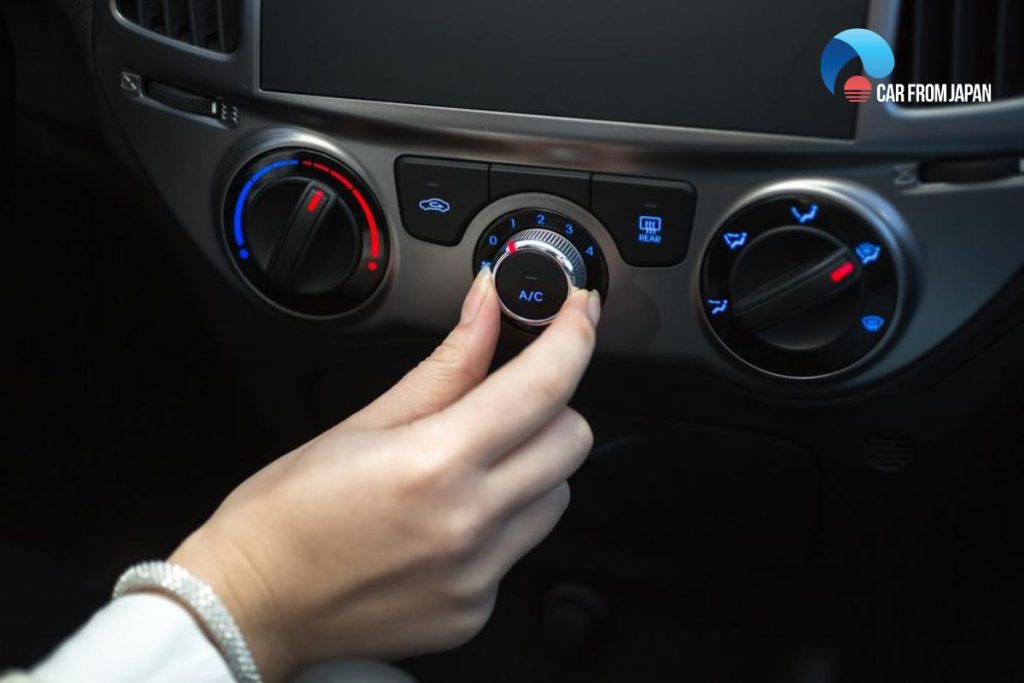Nothing could be more torturous than driving your car on a hot summer day but not being able to turn the AC on. Many car owners face a peculiar problem involving the car overheats when AC is on.
Sometimes, it happens when the air conditioning is on even for a few minutes. A hot car is not only discomforting but also leads to serious damage to several other components.
Contents
- Car Overheating When AC Is On: The Causes
- Car Overheats When AC Is On: The Solutions
- FAQs on Car Overheats and AC is ON
- Can a low refrigerant level cause the engine to overheat?
- Should I replace my thermostat if my car overheats when the AC is on?
- How to prevent my car from overheating when using the AC?
- Why does my engine smell like burning when it overheats with the AC on?
- Can extreme humidity make my car overheat faster when using the AC?
- Final Thoughts
Car Overheating When AC Is On: The Causes
The symptoms of the car overheating due to the air conditioner involve the heating up of the engine, dashboard, and seats a few minutes after turning on the AC. The restoration to normal temperature is pretty quick once you turn off the AC.
You should check into these components if your car overheats when AC is on:
Compressor overload
A malfunctioning AC compressor puts plenty of extra load on the engine. The engine can take so much strain so the motor will overheat if you push through your car past the breaking point.
The load placed on the engine is increased when the air conditioner starts running. The temperature will gradually increase when you combine this with pulling the heavy load.
At that time, the air conditioning system drew a huge amount of power from the engine, putting such a big load on the compressor that it could not handle it.
Also, the compressor makes the engine handle a rotational load. When it fails, it cannot do all the power handling, causing the engine overheat when AC on.

Incompetent cooling system
If the AC compressor is working fine, the problem can simply come from the cooling system. So the cooling system is another component to examine if your car heating up when AC is on.
The cooling system works to keep the air conditioning condenser cool, which heats up after you turn on the AC.
The overheating could be the result of clogged condenser fins, a defective condenser fan, or a faulty water pump that does not properly circulate the coolant.
The coolant system can also catch the corrosion occurring in the radiator tubes, resulting in preventing the proper coolant flow.
Besides, frequently, a bad water pump can be a reason to blame for this problem. The heat is not dispatched effectively when the water pump is not functioning properly.
Faulty fan
Sometimes, switching the AC on causes overheating when the car is stationary or moving at low speeds. It happens due to a clogged radiator passage that blocks the airflow.
The problem ultimately causes the failure of the fan switch, making the car overheats when AC is on.
Defective engine coolant temperature sensor
Overheating due to the problem is rare but not absolutely impossible. A faulty sensor will show a ‘hot’ reading whether or not you turn on the AC. In that case, you have to replace it or go to a mechanic to fix the issue.
Condenser in front of the radiator
The cool air can be diverted from its intended use if the condenser is placed in front of the radiator. Maintaining the low engine temperature can be challenging if there’s not enough air in the radiator.
Condenser failure is always a possibility. Over time, the condenser fins easily accumulate dirt and rust, so the heat transfer will not be effective when the condenser fins are clogged.

Read More: Why Does the Car AC Smell Bad?
Car Overheats When AC Is On: The Solutions
As soon as your car starts overheating you will need to identify the issue. You can connect an OBD scanner to determine what is happening to your car.
Your code scanner can assist you in identifying the reason causing the problem when the engine warning light is on.
So what should we do when your car overheats when the AC is on but you can’t seem to stop it? Don’t worry!
Taking a few measures will help you to avoid this problem and keep the air conditioning system functional for a long time.
- Check the coolant level
It’s best to start with the coolant level before you take any significant steps. It sounds quite simple because you just need to add the coolant as its standard. However, if you notice the low-level coolant, you also need to check for leakage.
The seal, gasket, and holes all are probably worn out over time which makes it possible for the fluid to seep out. Our recommendation in this situation is not to add any fluid to the coolant tank until the leakage is recovered.
- AC’s gas
The gas used in the AC sometimes does not suit the type or model of the car. Have a mechanic check the compatibility and refill the gas if it does not match.
- Check radiator and condenser
Check and make sure that the radiator and condenser don’t have any damage. If you detect a faulty radiator you should fix or replace this part as soon as possible.
You can spare yourself from a much higher bill than with an engine replacement with the price of a radiator replacement. Clean the radiator on a regular basis to remove any debris and contamination.
Install an air pressure gauge at one of the radiator ends to check the airflow. You can leak the radiator by using a radiator testing kit.
- Overheating could be the result of air getting trapped in the coolant system. Flush it to release the extra air and restore the normal condition.
- Change the coolant mixture every two years.
- Add water to the radiator if it is dry.
- Refill and diagnose the AC system
Refill it If the shortage of the AC refrigerator can be blamed. To lessen the load of your engine, your AC will work much better.
Watch this video from Online Mechanic Tips to know more about the relations between Car overheating and AC’s ON!
FAQs on Car Overheats and AC is ON
Can a low refrigerant level cause the engine to overheat?
Not directly, but a low refrigerant level can cause the AC compressor to work inefficiently or cycle excessively.
This increases strain on the engine, which can contribute to overheating if the cooling system isn’t in peak condition.
Should I replace my thermostat if my car overheats when the AC is on?
Possibly. A stuck-closed thermostat can restrict coolant flow, causing overheating, especially when extra heat from the AC is added.
If your car consistently overheats, checking or replacing the thermostat might help.
How to prevent my car from overheating when using the AC?
– Check coolant levels: Low or old coolant reduces the system’s ability to dissipate heat.
– Inspect the radiator fan: Make sure the fan operates properly when the AC is on.
– Clean the condenser and radiator: Remove dirt and debris to improve airflow.
– Check the serpentine belt: Ensure it’s in good condition and properly tensioned.
– Test the thermostat: Replace if it’s sticking or malfunctioning.
Why does my engine smell like burning when it overheats with the AC on?
A burning smell could indicate leaking coolant hitting hot engine parts, an overheating serpentine belt, or an AC compressor that’s failing under load.
Can extreme humidity make my car overheat faster when using the AC?
Yes, high humidity can make the AC system work harder to remove moisture from the air, increasing the load on the engine and potentially causing overheating if the cooling system is weak.
Final Thoughts
Engine overheating can be a very serious problem that drivers need to be considered. Car overheats when AC is on can be a rare problem for some people but the consequence will be considerable.
If this problem happens to your car, you should have timely methods to handle it. Hopefully, the information we share in this post will be useful for you.




Nice message
Nice coment